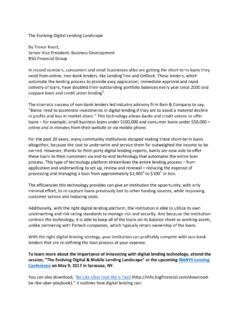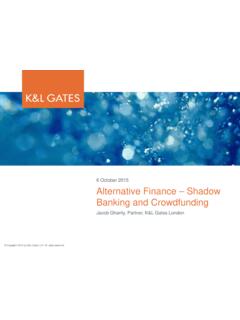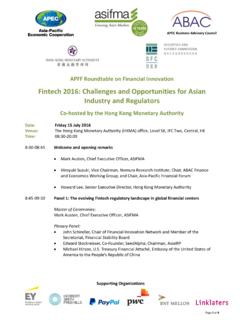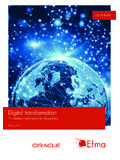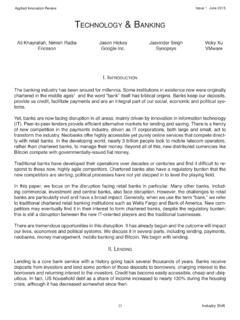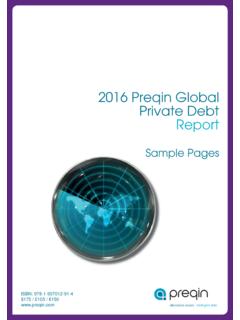Transcription of Marketplace Lending, Direct Lending and …
1 1 Marketplace Lending , Direct Lending and SecuritisationRobert Reoch February 20162 The changing face of banking, shadow banking, Direct Lending and Marketplace Lending (MPL) The growth of Direct and Marketplace Lending Marketplace Lending in context Implications for traditional financial institutions The benefits of bank / MPL collaboration Single loan securitisation A new source of systemic risk? Outlook for MPLM arketplace Lending , Direct Lending and Securitisation3 Changing face of banks, shadow banking, Marketplace lendingBanks:Less leverage, more capital, risk averseCDOs etc:Complex levered products have goneSecuritisation: Returning slowlyDirect and Marketplace Lending :Can it fill the funding gap?
2 4 Direct Lending landscape: across local marketsSource: Deloitte5 Direct Lending landscape: on the increase in Europe Source: Deloitte6 Marketplace Lending landscape: continues to globaliseSource: EY, Cambridge Centre for Alternative Finance, Cambridge Judge Business SchoolSource: Crosslend 2005 P2P Lending starts in the UK Followed in the US in 2006 (Prosper) and 2007 ( Lending Club) China P2P market starts in 2010 2015 significant global volumes and China activity7 China makes up 66% of global MPL marketRapid global MPL growthSource: CrosslendSource: CrosslendSource: World Bank, Federal Reserve, ECB, Bank of England.
3 Or of SME and consumer lendingMinimal MPL penetration of banking sectorSource: World Bank, Federal Reserve, ECB, Bank of England, National Bureau of Statistics of China010,00020,00030,00040,00050,00060,0 0070,000 USAUKEU (ex uk)China(US$m)010,00020,00030,00040,0005 0,00060,000201220132014 USAUKEUC hinaUSA, 22EU, 1UK, 7CN, 6005,00010,00015,00020,00025,00030,00035 ,00040,000 USAEUUKCN(US$bn)GDPB anksP2 PUSA, 22EU, 1UK, 702004006008001,0001,2001,400 USAEUUK(US$bn)SMEC onsumerP2 PMarketplace Lending in context8 Banks aren t Lending Impact of 2008 crisis still being felt De-levering and increased capital requirements Government bonds yielding close to zero Negative yields for maturities < 5 years Traditional fixed income assets such as corporate bonds have been heavily bought followed QE and hence yields are very low MPL assets yield 5% - 15% Very appealing to institutional investors trying to match previous performanceIf it s so small, why all the fuss?
4 9 Cost advantage of MPL vs. banks MPL superior NIM Data transparency MPL uses different data differentlyNet interest margin for all US banksLoan size slider provides information onuser 1987 1990 1993 1996 1999 2002 2005 2008 2011 2014(%)Source: ZopaSource: Federal reserve economic dataSource: Lending ClubData plentiful & increasingly useful forperformance analysisImplications for traditional financial services10 The basic role of banks: transformation of risk, maturity and liquidity But transformation is not always needed US economy 25% bank financed, Europe 75% Cost benefit analysis not compelling (US banking market)1: 1950s: 3% of salaries and 7% of corporate profits 1980s: 7% of salaries and 34% of corporate profits Layers of non-complementary regulation make it hard for banks to expand and contract with economic cycles Banks used to be a counter-cyclical brake Mark-to-market accounting has made banks more pro-cyclical1.
5 Prof Benjamin Freidman, Harvard UniversityYou wouldn't structure banks this way if you started now11 Bank liquidity lines for MPL site Main beneficiary is MPL as matching liquidity to Lending is MPL s main challenge Bank can diversify by filtering investment via MPL White-labelling MPL sites Banks could make loans shared with MPL sites MPL site gets loan origination, bank gets customer for on-sell of fee based products Both bank and MPL benefit Banks manage credit limits via MPL Customer that hit internal credit limits have excess funded by MPL Main beneficiary is the bank.
6 Separation of risk from relationshipActive Credit Portfolio ManagementThe benefits of bank / MPL cooperation12 Institutional investors face obstacles running pan-European portfolios of MPL assets Bank collaboration with MPL will face similar obstacles Single loan securitisation Transform a traditional credit instrument into a Note Settlement, ISIN, bond documentation Remove some of the cross-border hurdles for plain vanilla Lending by non-banks Easier distribution of traditional credit instruments Allows granular asset selection, ensures transparency Secondary market benefits CrossLend platform transforms each loan into a bond Unique securitisation infrastructure Potential benefits for banks and institutional investorsThe next step forward: single loan securitisationBankP2 PDirect LendingCapital MarketsProduct13 2013: Lending Club, Santander (USA) Bank acquires LC loans 2013: Lending Club, Titan Bank (USA), Congressional Bank (USA) Banks to buy and offer LC loans 2014: RainFin (South Africa), Barclays Africa Bank acquires 49% stake 2014.
7 Society One (Australia), VC fund of Westpac Fund takes equity stake 2014: Lending Club, Union Bank (USA): Strategic alliance whereby bank buys loans, both cross-sell new credit products 2014: Funding Circle (UK), Santander (UK) Bank to refer SMEs to CF platform 2014: Harmoney (NZ), Heartland Bank (NZ) Bank takes 10% stake and provides funding line 2015: Funding Circle, Assetz Capital (UK), RBS Bank to refer rejected loan applicants to the two CF platforms 2015: Lending Club, Alibaba Group LC to offer financing to US businesses buying from Chinese suppliers on 2015: China Rapid Finance, China Construction BankExamples of Marketplace Lending partnerships14 Old shadow banking Opaque, complex, levered 50% of credit in 2007 off bank balance sheets Some aspects were beneficialSource: CrosslendSource: Pozsar, Adrian, Ashcraft, & Boesky, July 2010 Marketplace Lending Transparent, simple, fully funded Growing use of leverage needs monitoring Effects of interest rate normalisation?
8 Systemic implications small due to small market size / transaction sizesA new source of systemic risk to be over-regulated?15 Confluence of financial and economic events Combined with development of financial technology Growth in China due to similar perfect storm Numbers too small for noticeable impact today Few regulatory obstacles, therefore significant growth More than just a better way of doing something Banks unlikely to stand back and watch Contained by an increasingly sophisticated and demanding crowd Likely to increase collaboration with MPL Expect innovation.
9 Consolidation and economic benefits Consolidation will produce banks in all but name Multiplier effect with benefit global economyOutlook for Marketplace lending16
